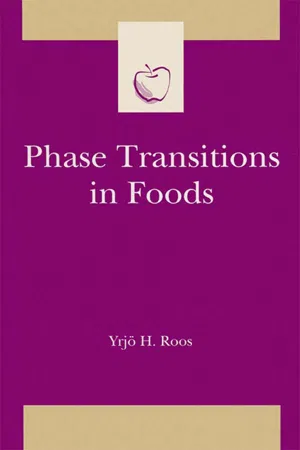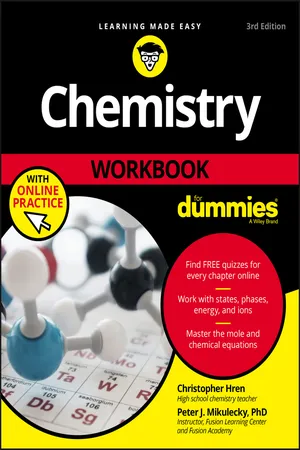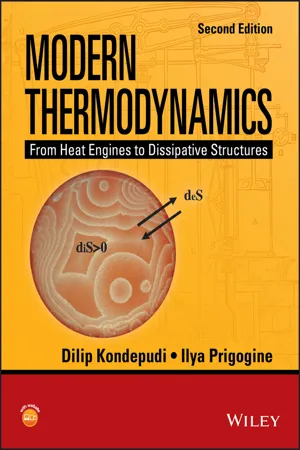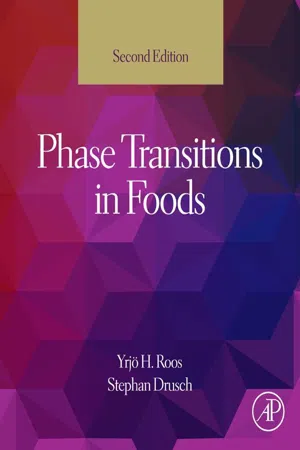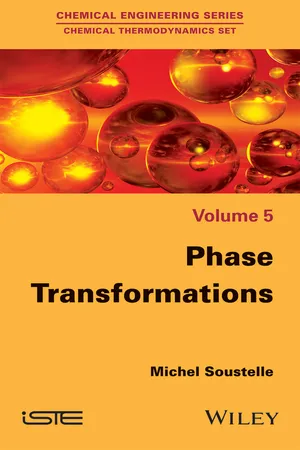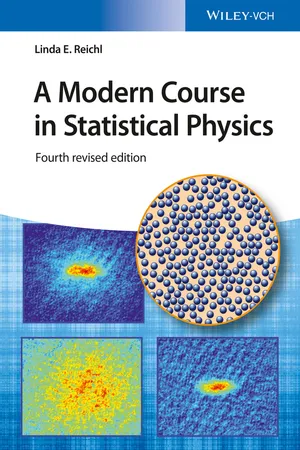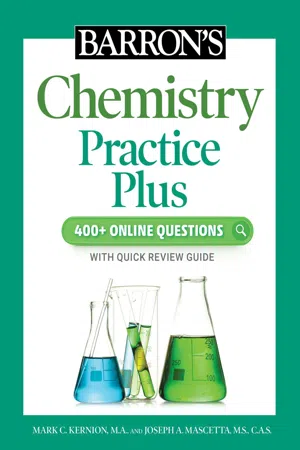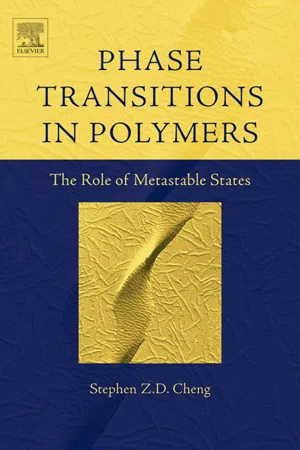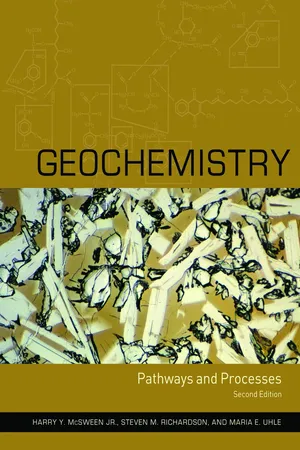Chemistry
Phase Changes
Phase changes refer to the physical transformations that occur when a substance changes from one state of matter to another, such as from solid to liquid, liquid to gas, or vice versa. These changes are driven by alterations in temperature and pressure, and involve the absorption or release of energy. Examples of phase changes include melting, freezing, vaporization, condensation, and sublimation.
Written by Perlego with AI-assistance
Related key terms
Related key terms
1 of 4
Related key terms
1 of 3
12 Key excerpts on "Phase Changes"
- eBook - ePub
- Yrjö H. Roos, Yrjo H Roos, Steve Taylor(Authors)
- 1995(Publication Date)
- Academic Press(Publisher)
Phase transitions in foods are often a result of changes in composition or temperature during processing or storage. Knowledge of transition temperatures and of the thermodynamic quantities is particularly important in understanding such processes as evaporation, dehydration, and freezing. These processes are governed by the transition of water into the gaseous or crystalline state. Foods are complex materials that contain at least one component compound and water. The dependence of the physical state of various materials as a function of temperature can be characterized with phase diagrams. Changes that are observed at the transition temperatures can be used for the description of the effect of the transition on physical properties.A. Phase Diagrams
A phase can be defined to be a physically and chemically homogenous state of a material that is clearly separated from other matter. A phase transition can be observed from a change in internal energy, U, volume, V , number of moles, n, or mass. The change in phase is a result of a change in temperature or pressure. An equilibrium, e.g., between ice and water, requires that the two phases have the same temperature and pressure. Also the chemical potential, μ, and Gibbs energy, G, of the material are the same in both phases. The basic three physical states of chemically pure substances are solid, liquid, and gaseous states. These states are equilibrium states and the change of one state to another state occurs at exact temperature and pressure conditions that are specific to each material.The relationships between the physical state, pressure, temperature, and volume can be shown in three-dimensional phase diagrams. Such diagrams show surfaces that indicate values for the state variables at equilibrium conditions. It can be shown that at most equilibrium situations two phases may coexist. The possible combinations of coexisting phases are solid and liquid, solid and gas, and liquid and gas. All three phases may coexist only at the triple point, which has exact temperature and pressure conditions that are specific for each material. Two-dimensional projections of the three-di-mensional phase diagrams are often more useful in practical applications. As shown in Figure 1.1 - Chris Hren, Peter J. Mikulecky(Authors)
- 2017(Publication Date)
- For Dummies(Publisher)
Part 3Examining Changes in Terms of Energy
IN THIS PART … Understand phases in terms of energy. There are many phases of matter, and those phases of matter depend entirely upon the behavior and energy of atoms.Get the scoop on gas laws. The behavior of compounds in the gas phase can change dramatically if you alter the pressure, temperature, or volume at which they’re found. Certain formulas allow chemists to determine what type of change will take place.Survey the basics of solutions. Chemists usually measure the concentration of solutions in terms of molarity. In addition, temperature and dilution can alter solution chemistry. Beyond basic concentration measurements come colligative properties, such as freezing point depression and boiling point elevation.Take a look at thermochemistry. Different substances heat up at different rates due to differences in specific heats. Chemical reactions often give off energy, which you can calculate using Hess’s law.Passage contains an image Chapter 10
Understanding States in Terms of Energy
IN THIS CHAPTERExplaining the kinetic molecular theoryMoving between phasesWhen asked, children often report that solids, liquids, and gases are composed of different kinds of matter. This assumption is understandable, given the striking differences in the properties of these three states. Nevertheless, for a given type of matter at a given pressure, the fundamental difference between a solid, a liquid, and a gas actually is the amount of energy within the particles of matter. Understanding the states of matter (phases) in terms of energy and pressure helps to explain the different properties of those states and how matter moves between the states. We explain what you need to know in this chapter.Describing States of Matter with the Kinetic Molecular Theory
Imagine two pool balls, each glued to either end of a spring. How many different kinds of motion could this contraption undergo? You could twist along the axis of the spring. You could bend the spring or stretch it. You could twirl the whole thing around, or you could throw it through the air. Molecules can undergo these same kinds of motions, and they do so when you supply them with energy. As collections of molecules undergo changes in energy, those collections move through the states of matter — solid, liquid, and gas. The body of ideas that explains all this is called the kinetic molecular theory.- eBook - ePub
- Francoise Brochard-Wyart, Pierre Nassoy, Pierre-Henri Puech(Authors)
- 2019(Publication Date)
- CRC Press(Publisher)
CHAPTER 3Phase Transitions
3.1 Physical Transformations of Pure Substances
An ice cube melts and water evaporates when heated. The solid becomes a liquid, which then turns into vapor, and all these transformations are reversible. By definition, the phase of a substance refers to a chemically and physically homogeneous state of matter. A substance may have solid, liquid, and gas phases and often polymorphic solid phases such as graphite and diamond for carbon. A phase transition is the spontaneous conversion of a phase into another. For a given pressure it occurs at a characteristic temperature. At atmospheric pressure, ice melting occurs at 0°C and water boiling at 100°C. The transition temperature is defined by the equality of the chemical potential of a given element in the two phases. A phase diagram (Figure 3.1 ) is a chart that defines the conditions or physical parameters, such as temperature and pressure, at which the different phases are present or coexist.FIGURE 3.1 (A) Phase diagram in (T ,P ) coordinates and in (T ,V ) coordinates; (B) Compression isotherm of a gas in coordinates (P ,V ). Notations: T = temperature, P = pressure, V = volume, S = solid phase, L = liquid phase, G = gas phase.All phase diagrams can be discussed from a general principle derived by J.W. Gibbs, [1 ] namely the phase rule:v = C + 2 − φwhere v is the variance, i.e. the number of intensive variables (pressure, temperature, …) that can be changed independently without changing the number of phases, C is the number of components, i.e. the number of chemical species, and φ is the number of phases.3.1.1 One-Component Systems
We will begin with the simple case of one component (C = 1), which exists only in three phases according to the phase rule:- Crystal
- eBook - ePub
Modern Thermodynamics
From Heat Engines to Dissipative Structures
- Dilip Kondepudi, Ilya Prigogine(Authors)
- 2014(Publication Date)
- Wiley(Publisher)
7 Thermodynamics of Phase ChangeIntroduction
Transformations from a liquid to a vapor phase or from a solid to a liquid phase are caused by heat. The eighteenth century investigations of Joseph Black revealed that these transformations take place at a definite temperature: the boiling point or the melting point. At this temperature the heat absorbed by the substance does not increase its temperature but is ‘latent’ or concealed; the heat's effect is to cause the change from one phase to another, not to increase the substance's temperature. Joseph Black, who clarified this concept, measured the ‘latent heat’ for the transformation of ice to water.Under suitable conditions, the phases of a compound can coexist in a state of thermal equilibrium. The nature of this state of thermal equilibrium and how it changes with pressure and temperature can be understood using the laws of thermodynamics. In addition, at the point where the phase transition takes place, some thermodynamic quantities, such as molar entropy, change discontinuously. Based on such discontinuous changes of some thermodynamic quantities, such as molar heat capacity and molar entropy, phase transitions in various materials can be classified into different ‘orders’. There are general theories that describe phase transitions of each order. The study of phase transitions has grown to be a large and interesting subject, and some very important developments occurred during the 1960s and the 1970s. In this chapter, we will only present some of the basic results. For further understanding of phase transitions, we refer the reader to books devoted to this subject [1–3].7.1 Phase Equilibrium and Phase Diagrams
The conditions of temperature and pressure under which a substance exists in different phases, i.e. gas, liquid or solid, are summarized in a phase diagram. A simple phase diagram is shown in Figure 7.1 - eBook - ePub
- Yrjo H Roos, Stephan Drusch(Authors)
- 2015(Publication Date)
- Academic Press(Publisher)
G , of the material are the same in both phases. The basic three physical states of chemically pure substances are solid, liquid, and gaseous states. These states are equilibrium states and the change of one state to another state occurs at exact temperature and pressure conditions that are specific to each material.The relationships between the physical state, pressure, temperature, and volume can be shown in three-dimensional phase diagrams. Such diagrams show surfaces that indicate values for the state variables at equilibrium conditions. It can be shown that at most equilibrium situations two phases may coexist. The possible combinations of coexisting phases are solid and liquid, solid and gas, and liquid and gas. All three phases may coexist only at the triple point, which has exact temperature and pressure conditions that are specific for each material. Two-dimensional projections of the three-dimensional phase diagrams are often more useful in practical applications. As shown in Figure 1.3 , the two-dimensional phase diagrams show equilibrium lines for pressure and temperature for each phase. One of the most important of such two-dimensional phase diagrams for foods is that of water.Figure 1.3 A schematic phase diagram showing the equilibrium curves between various physical states and their dependence on pressure and temperature.The molecular organization of the liquid and gaseous phases are similar but different from that of the highly ordered crystalline solid phase. The equilibrium curve between the liquid and gaseous states ends at the critical state. At the critical point, the temperature and pressure of both phases become equal and the two phases can no longer be separated. Thus, the critical temperature is the highest temperature at which the liquid state may exist. The pressure at the critical point is called critical pressure - eBook - ePub
- Michel Soustelle(Author)
- 2016(Publication Date)
- Wiley-ISTE(Publisher)
1 Phase Transformations of Pure SubstancesIn this chapter we shall examine the transformations undergone by a definite pure compound, with no chemical alteration. These transformations belong to the category of phase transitions, or phase transformations. Hence, this chapter excludes the transformations of isomerization and decompositions which are accompanied by a chemical alteration – i.e. a modification of the molecule.1.1. Standard state: standard conditions of a transformation
The “standard state” of a substance at temperature T is defined as the state of the pure substance at that temperature, at a pressure of 1 bar and as its stable state of aggregation in these conditions (solid, liquid or gas). If the substance is a gas, its behavior is perfect. If the pure substance is a crystalline solid, its stable state of aggregation determines the crystalline system. A transformation takes place in standard conditions if it occurs with the components in their standard state in the final state. This means that at the start of the reaction, the substance is in a non-standard state, which is unstable, and that it returns to its stable standard state at the end. Thus, only the state of aggregation may possibly have been modified by the transformation. This is indeed a phase transformation, in that the state of aggregation defines a phase.1.2. Classification and general properties of phase transformations
Phase transitions are classified into different types. The advantage of classifying definite compound transformations depending on their order lies in the fact that a series of relations characterizes each order.The first classification of these transitions is attributable to Ehrenfest, in which we say that a transformation is of order n when at least an nth derivative of the characteristic function in relation to its canonical variables undergoes a discontinuity for certain values of those variables, when the derivatives of order less than n - eBook - ePub
- Linda E. Reichl(Author)
- 2016(Publication Date)
- Wiley-VCH(Publisher)
4 The Thermodynamics of Phase Transitions4.1 Introduction
A thermodynamic system can exist in a number of different phases and the macroscopic behavior of these various phases can differ dramatically. Generally, systems become more ordered as temperature is lowered because forces of cohesion begin to overcome thermal motion and atoms can rearrange themselves into more ordered states. Phase Changes occur abruptly at some critical temperature, although evidence that a phase change will occur can be found on a macroscopic scale as the critical temperature is approached. In this chapter we will be concerned with the thermodynamics of phase transitions – that is, the description of phase transitions in terms of macroscopic variables. In later chapters we shall study them from a microscopic point of view.The first step in analyzing Phase Changes is to map out the phase diagram for the system. At a transition point, two (or more) phases can coexist in equilibrium with each other. Since phases can exchange thermal and mechanical energy and matter, equilibrium occurs when the chemical potentials of the phases become equal for given values of Y and T. From this equilibrium condition, we can determine the maximum number of phases that can coexist and, in principle, find an equation for the regions of coexistence (the Clausius–Clapeyron equation, for example).Phase transitions can be divided into two classes according the behavior of the Gibbs free energy. Phase transitions with discontinuous first derivatives of the Gibbs free energy (taken with respect to T and Y) are called first-order phase transitions. Phase transitions with continuous first derivatives, but discontinuous higher order derivatives, are called continuous phase transitions. We give examples of both in this chapter.Classical fluids provide some of the most familiar examples of first-order phase transitions. The vapor–liquid, vapor–solid, and liquid–solid transitions are all first order. For these phase transitions, we can use the Clausius–Clapeyron equation to find explicit approximate equations for the coexistence curves. Since the vapor–liquid transition terminates in a critical point, we will focus on this transition and compare the observed behavior of the vapor–liquid coexistence region to that predicted by the van der Waals equation. - Mark Kernion, Joseph A. Mascetta(Authors)
- 2022(Publication Date)
- Barrons Educational Services(Publisher)
CHAPTER 7Liquids, Solids, and Phase Changes
Learning Objectives In this chapter, you will learn how to:Describe the states of matter (solids, liquids, and gases).Describe and compare the important properties of solids, liquids, and gases.Describe the various types of phase change.Analyze a phase diagram.Explain the use of liquid water as a common solvent.Solve solubility and concentration problems.Solve colligative property problems in a qualitative manner.Describe the continuum of water mixtures, including solutions, colloids, and suspensions.Liquids and solids are considered condensed phases of matter. By itself, this is a significant differentiation from the phase of matter called a gas. But there are many other important characteristics that distinguish solids and liquids from gases as well as those that distinguish solids from liquids. Macroscopically (i.e., in a form visible to the naked eye), there are several ways to differentiate solids, liquids, and gases. But in order to understand the states of matter well, and in addition how they change from one to another, it is important to be able to envision these phases from a mind’s-eye perspective that takes into account what they are like on an atomic/molecular level.General Characteristics of Solids, Liquids, and Gases
Macroscopically, solids are seen as rigid materials that maintain their shape independent of the container they are in. This rigidity is what differentiates them from liquids and gases, which can both be described as fluid because they can flow and take on the shape of their containers. Although liquids and solids are different with regard to their visible shapes, they are similar with regard to their measurable volumes. Liquids, unlike gases, do not assume the volume of their container. Gases spread out to take up the volume of the container in which they find themselves. Solids act like liquids: their volume is not dependent upon or determined by the container they occupy. Table 7.1- Stephen Z.D. Cheng(Author)
- 2008(Publication Date)
- Elsevier Science(Publisher)
In this chapter, brief general descriptions are given for the thermodynamics and kinetics of phase transitions in simple, small molecules. This chapter is particularly designed to introduce the background research in this area. The chapter starts by reviewing, from a thermodynamic point of view, phase transitions in single component systems, including liquid–gas, crystalline solid–liquid, crystalline solid–solid, and transitions involving mesophases. The kinetic aspects of crystallization, melting, and mesophase transitions will be discussed specifically. The thermodynamic descriptions are then extended to multiple component systems, with particular attention to liquid–liquid phase separation, crystalline solid–liquid, and mesophase–liquid transitions of binary mixtures. A description of the kinetics of liquid–liquid phase separation in binary mixtures in the initial, intermediate, and late coarsening stages is also provided.1. Thermodynamics of Phase Transitions in Single Component Systems
1.1. An example of liquid–gas transitions: van der Waals gas
The first question which needs to be answered in discussing phase transitions is whether or not the phase transition is intrinsically possible. The answer to this question is based in thermodynamics. Let us first examine liquid–gas phase transitions. The condensation of a van der Waals gas will be used to illustrate the liquid–gas transition behavior.Three macroscopic thermodynamic properties—volume, pressure, and temperature—determine the physical state of a phase. We know that these three properties are not independent of each other. When two of these three properties are fixed, the third one is determined. The relationship among these three properties at thermodynamic equilibrium is called an equation of state. For an ideal gas, the most well-known equation of state is:(2.1)where P is the pressure, V is the volume, T is the temperature, NA is Avogadro's number, n is the number of moles of particles (atoms or molecules), and R is the gas constant, which is equal to NA k (k is the Boltzmann constant). The gas constant is used for mole-based calculations of particles; while, the Boltzmann constant is used for single particle calculations. The right side of Eq. (2.1) is a microscopic statistical description of an ideal gas, where N is the number of particles, m is the mass of the particles, and 〈v〉 is the average particle velocity. According to the description in Eq. (2.1)- eBook - ePub
- Christos Ritzoulis(Author)
- 2013(Publication Date)
- CRC Press(Publisher)
p .When the temperature reaches the boiling point, we can determine the entropy of vaporization ΔSvap and the enthalpy of vaporization ΔHvap for the transition from the liquid to gaseous state (always assuming that the change is reversible and isobaric):(2.19)ΔS=vap=qrevTvapΔHvapTvapAt this temperature, the heat supplied to the liquid breaks down the bonds that retain the structure of the liquid. Quantitatively, this presents itself as a reduction in enthalpy (latent heat of vaporization, ΔHvap ). The reduction in enthalpy leads to an increase in the entropic factor TS. More particularly, the increase in entropy means that the molecules will claim a much larger space, spreading to fill all of the volume available to them.In the gas phase, the supplied heat raises the temperature T. The change in temperature ΔT is determined by the thermal capacity of the material in the gas phase under constant pressure Cp .The above description constitutes the basis of phase diagrams. These diagrams present the individual phases of a material as a function of the variables of state (P, V, T). In Figure 2.1 , the phase diagram of a substance is presented schematically (not to scale). The sublimation line A gives the vapor pressure of the solid phase and, for a given pressure P, the sublimation point (the temperature for the direct transition from solid to gas phase, e.g., from ice to steam for water). The vapor pressure line B gives the boiling point (the temperature for the transition from liquid to gas phase, e.g., from liquid water to steam) for a given pressure P. The melting line C gives, for every value of pressure, the melting temperature (the temperature for the transition from solid to liquid phase, e.g., from ice to liquid water). The three plot lines meet at the triple point. This is characteristic for every material and indicates the point at which the three phases (liquid, solid, and gas) can coexist. For water, the triple point is ~273.16 K and ~4.59 mmHg. The vapor pressure line ends at the critical point, beyond which the boundary of the two phases (liquid and gas) ceases to exist. Here we define an additional fourth phase, the supercritical state, which has special properties. The pressure and temperature that equate to the critical point are referred to as the critical pressure and critical temperature, - eBook - ePub
Geochemistry
Pathways and Processes
- Harry McSween, Steven Richardson, Maria Uhle(Authors)
- 2003(Publication Date)
- Columbia University Press(Publisher)
CHAPTER NINE TEMPERATURE AND PRESSURE CHANGES Thermodynamics Again OVERVIEWThis chapter expands on the thermodynamic principles introduced in chapter 3 and provides the preparation for the next chapter on phase diagrams. We first give a thermodynamic definition for equilibrium. We also derive the phase rule and explore its use as a test for equilibrium. The effects of changing temperature and pressure on the free energy of a system at equilibrium are analyzed, and a general equation for dḠ at P and T is formulated. P-T and Ḡ -T diagrams for one-component systems are introduced. The utility of the Clapeyron equation in constructing or interpreting phase diagrams is explored. We then introduce concepts that are necessary for understanding systems with more than one component. Raoult’s law and Henry’s law are defined, and expressions for the chemical potentials of components that obey these laws are derived. The concept of standard states is introduced, and we examine how activity coefficients are defined in mixing models. The usefulness of these concepts is illustrated by discussing formulation of a geothermometer and a geobarometer.WHAT DOES EQUILIBRIUM REALLY MEAN?In previous chapters, we have introduced and made use of the concept of thermodynamic equilibrium. By this time, you should be comfortable with the idea that the observable properties of a system at equilibrium will undergo no change with time, as long as physical conditions imposed on the system remain constant. Although this statement is commonly used to define equilibrium, it is actually a consequence of equilibrium rather than a strict definition of it. A more rigorous definition of the equilibrium state that we have not seen before is: a condition of minimum energy for that portion of the universe under consideration.We have also learned that Gibbs free energy is a convenient way of describing the energy of a system. The relationship of this thermodynamic quantity to temperature, pressure, and the amounts of the constituent components of a system is given by the following: - eBook - ePub
200 Science Investigations for Young Students
Practical Activities for Science 5 - 11
- Martin Wenham(Author)
- 2000(Publication Date)
- SAGE Publications Ltd(Publisher)
6States of Matter and Physical Change
6.1: Solids, liquids and gases
Most materials and objects which children encounter in everyday life are fairly obviously in one of three states of matter: solid, liquid or gas. Observing materials to find out how they are classified in this way is an essential preliminary to investigating changes between the three states and ways in which they may be brought about. The three states of matter are sometimes written or spoken about as if there were always sharp distinctions between them; but particularly between the solid and liquid states the distinction is not always clear (Activity 6.2.2 ) and even when it is, it may not appear to be (Activity 6.1.2 ).Activity 6.1.1
Distinguishing solids from liquids
Equipment and materials: A range of (unlabelled) solid objects in a variety of materials, e.g. wood, stone, rubber (elastic bands), paper, modelling clay, plastics, metals. A range of liquids in labelled screw-top jars or bottles with tops sealed on, e.g. water, vegetable oil, thick sugar syrup, PVA glue; disposable cup; dropper; plastic or metal tray.- From all the objects in front of you, pick out the bottles or jars with liquids in them. Put them on one side to look at later.
- Look at the objects which are left. Try to identify the materials of which they are made.
- Try to change the shape of these objects by bending, pulling, squashing and twisting them in your hands. Do not break any of the objects: just find out if you can make them change shape.
- Are these objects solid or liquid? (They are solid.) Are they all solid? (Yes.) Are some more solid than others?
Children may mistakenly answer ‘Yes’ to the last question because they may equate solidity with rigidity or hardness and think that soft, squashy and stretchy materials like modelling clay and elastic bands are less solid than hard materials such as metal or stone.- What properties do all these objects have which makes us call them ‘solid’?
This may need some discussion. The scientific view is that solids maintain their shape without support, although these shapes can be changed by applying forces to them. As children might put it, solids ‘have their own shape’ and ‘stand up on their own’; but there are solid materials which need further investigation to find out how they behave (Activity 6.1.2
Index pages curate the most relevant extracts from our library of academic textbooks. They’ve been created using an in-house natural language model (NLM), each adding context and meaning to key research topics.
Explore more topic indexes
Explore more topic indexes
1 of 6
Explore more topic indexes
1 of 4
